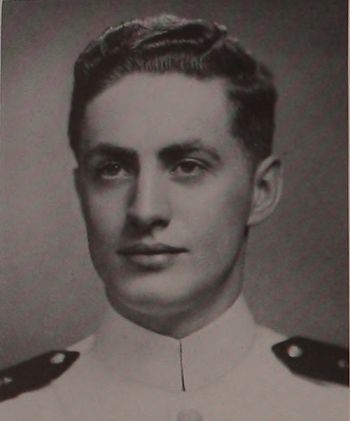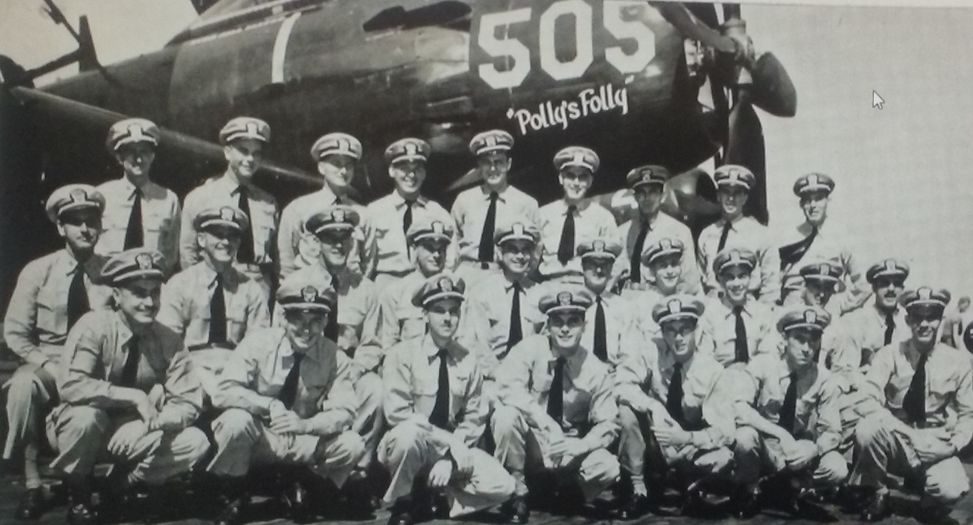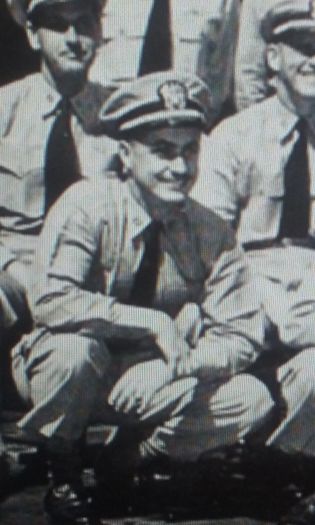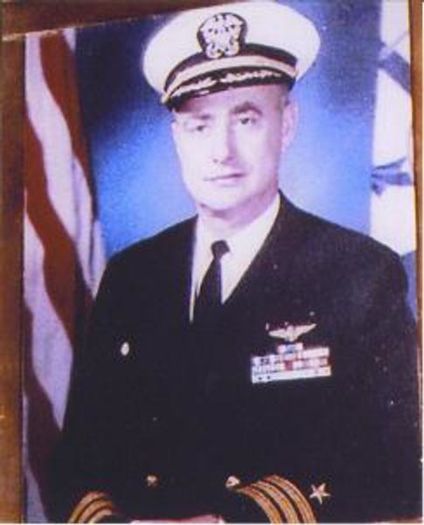JAMES D. LAHAYE, CDR, USN
James Lahaye '47
Lucky Bag
From the 1947 Lucky Bag:
James David LaHaye
Green Bay, Wisconsin
J.D. came to us from the cheese state—Wisconsin. Before entering the Academy he served in the Fleet as radarman, and used this superior knowledge of radar during first class year to bilge us all. Being French, he at once took up the art of fencing, and by hard work secured himself a berth on the team, and his N star. He was always threatening to use the pap during youngster year, but first class year he seldom mustered the ambition to completely fill out a form two. J. D. will always be remembered by his shipmates for his quick wit and congeniality.
James was on the staff of the 2nd Battalion (Winter set) and a member of the fencing team.
The Class of 1947 was graduated in June 1946 due to World War II. The entirety of 2nd class (junior) year was removed from the curriculum.

James David LaHaye
Green Bay, Wisconsin
J.D. came to us from the cheese state—Wisconsin. Before entering the Academy he served in the Fleet as radarman, and used this superior knowledge of radar during first class year to bilge us all. Being French, he at once took up the art of fencing, and by hard work secured himself a berth on the team, and his N star. He was always threatening to use the pap during youngster year, but first class year he seldom mustered the ambition to completely fill out a form two. J. D. will always be remembered by his shipmates for his quick wit and congeniality.
James was on the staff of the 2nd Battalion (Winter set) and a member of the fencing team.
The Class of 1947 was graduated in June 1946 due to World War II. The entirety of 2nd class (junior) year was removed from the curriculum.
Loss
From VF-11/111 ‘Sundowners’ 1942–95:
Following the Tonkin Gulf incident in August 1964, US forces were increasingly committed to Southeast Asia. Cdr James D LaHaye led VF-111's 1965 deployment, flying F-8Ds in CVW-2 aboard Midway. LaHaye was an experienced Crusader pilot, having ejected from a VF-32 aircraft in 1958. In a typical air wing composition of the period, VF-111's Crusaders were teamed with VF-21's F-4B Phantom IIs. The deployment was a long one, extending from early March to late November, and it incurred significant losses — 17 in combat and five in accidents, resulting in 12 airmen being killed and five captured.
On 5 May Cdr LaHaye participated in an attack on Vinh airfield, flying NE 451 (BuNo 148637). Armed with Zuni rockets and 20 mm cannon, he rolled in to suppress North Vietnamese gunners, but 37 mm AAA struck hard. The skipper radioed, 'I've been hit! Have fire warning light!' Streaming fuel, the stricken Crusader turned eastward for the Gulf of Tonkin. Other 'Sundowners' watched the CO descending wings level until he hit the water. There was no apparent reason for LaHaye's failure to eject, some speculating that his seat had suffered a malfunction.
Biography
From researcher Kathy Franz:
A native of Stevens Point, Wisconsin, James attended St. Stephen’s Parochial School. His family moved to Green Bay in the late 1930s, and he graduated from West High School. In 1940 James and his two brothers Robert and William worked as record clerks for the National Youth Administration (A New Deal Agency.)
James’ Navy assignments took him to schools in Monterey, California; Troy, New York, where he received a M. A. degree in aeronautical engineering at Rensselaer Polytechnical Institute; and the Army War College in Carlisle, Pennsylvania, where he received a M. A. degree in international relations. During the Korean conflict, he flew 53 combat missions from the aircraft carrier U. S. S. Bon Homme Richard.
A requiem mass was said for him on May 14 at the Airmen’s Chapel at the Miramar Naval Air Station in California.
He was predeceased by his brother William and his parents William and Lillian. His father was a salesman for the Copps Company in Stevens Point in 1930 and a surveyor on a W. P. A. project in Green Bay in 1940.
James was survived by his wife, the former Gloria Morgan of Tenafly, New Jersey; his children, Donald, Nancy and William; his stepmother; two brothers Robert, a retired Army lieutenant colonel, and Major John of Kincheloe Air Force Base; a sister Mary, Mrs. John Locher; and an uncle Ben LaHaye.
He has a memory marker in Arlington National Cemetery and another at the Courts of the Missing in Hawaii.
Photographs
Distinguished Flying Cross
From Hall of Valor:
The President of the United States of America takes pride in presenting the Distinguished Flying Cross (Posthumously) to Commander James David LaHaye, United States Navy, for extraordinary achievement while participating in aerial flight as Pilot of an F-8D Crusader aircraft on 8 May 1965, while serving as Commanding Officer of Fighter Squadron ONE HUNDRED ELEVEN (VF-111), aboard U.S.S. MIDWAY (CVA-41), during operations against enemy aggressor forces in Vietnam. Leading a flight of eight aircraft on an anti-aircraft suppression mission against an enemy airfield, Commander LaHaye, in the face of heavy hostile anti-aircraft fire, initiated the strike for Attack Carrier Air Wing TWO and struck his target with devastating effect. When his aircraft sustained severe damage from anti-aircraft fire, he piloted the stricken jet through intense opposition away from enemy territory to the open sea.
General Orders: All Hands (June 1966)
Action Date: May 8, 1965
Service: Navy
Rank: Commander
Company: Fighter Squadron 111 (VF-111)
Division: U.S.S. Midway (CVA-41)
Test Pilot Experience
From "Dressing for Altitude: U.S. Aviation Pressure Suits":
On July 25, 1957, Lt. James D. LaHaye, a test pilot with Air Development Squadron Three (VX-3) from Naval Air Station (NAS) Atlantic City, N.J., was testing an early F8U-1. The fight, intended to collect zoom-climb performance data, became a real-world emergency when the Pratt & Whitney J57 turbojet experienced a flameout at 52,000 feet. At that point, the Mark III suit LaHaye was wearing did exactly what it was designed to do: it inflated. Despite the relative discomfort, LaHaye immediately descended and began the air-start procedures as he passed through 35,000 feet, with the engine finally coming back to life at 30,000 feet.
After the flight, LaHaye reported the suit did not overly restrict his movements while pressurized, that he had no difficulty flying the aircraft, and the suit did not restrict visibility. “In the uninflated condition, the visibility afforded by the suit was far better than I had anticipated. Since the back kit of the full-pressure suit moves the pilot forward, I expected to have difficulty in seeing the switches on the after parts of the consoles. But I found that I could see and reach all necessary switches.” LaHaye, however, did find that the bulk of the straps and other items at the shoulders had an adverse effect on mobility of the helmet because it restricted the movement of the neck ring.
LaHaye continued, “My overall impression of this suit as compared to the partial-pressure suit is that it has very little less mobility, visibility, and comfort in the uninflated condition. In the inflated condition, it is much more comfortable and affords much more mobility and visibility than an inflated partial- pressure suit.” A recurring theme of pressure suits is that pilots frequently find fewer faults with the garments during actual emergencies than they do during routine evaluations. Credit the adrenaline.
Memorial Hall Error
James' last name is spelled incorrectly (with a space) on the killed in action panel in the front of Memorial Hall.
Related Articles
Charles Glisson, Jr. ’47 was also a member of the fencing team.

The "category" links below lead to lists of related Honorees; use them to explore further the service and sacrifice of alumni in Memorial Hall.


